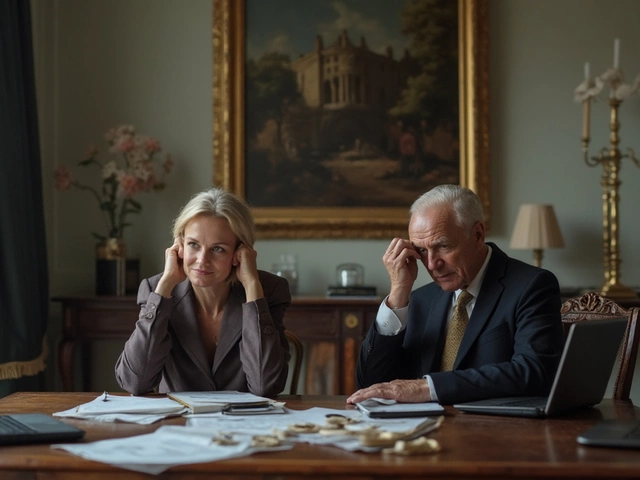CIO Disadvantages in Charitable Trusts: What to Watch Out For
Swapping your trusty charitable trust for a Charitable Incorporated Organisation (CIO) sounds easy, right? Get ready for curveballs. Sure, a CIO offers protection for trustees and that shiny 'incorporated' tag, but not everyone walks away happier.
There’s a real buzz these days about CIOs, especially if you run a small- to medium-sized charity. But behind the excitement, there are some nagging questions. What could actually go wrong if you make the jump? Is it just admin headaches, or does it hit deeper—like in fundraising, trust with donors, or just plain keeping the ship running day-to-day?
Let's break down what nobody admits when talking up CIOs. This isn't about doom and gloom, just the stuff it’s way better to know before you get letters from the Charity Commission you don’t fully understand. Buckle up; we're skipping the textbook and going straight for the stuff that actually happens behind the scenes.
- What Is a CIO in Plain English?
- Challenges with Regulation and Oversight
- The Catch with Flexibility and Administration
- Impact on Fundraising and Donor Confidence
- When Keeping a Trust Makes More Sense
What Is a CIO in Plain English?
Before we get into the downsides, you need to actually know what a CIO is without needing a law degree. CIO stands for Charitable Incorporated Organisation. It’s a legal structure created in the UK just for charities, first offered in 2013. Think of it as a halfway point between being an old-school charitable trust and a full-on charity limited company.
This structure was invented to give charities a way to get the legal perks of a company—like limited liability—without making them deal with Companies House. You literally only file reports with the Charity Commission, which for small teams, sounds like a huge time saver. Basically, it combines the charity world’s rules with some of the protections businesses usually get.
Here’s what sets a CIO apart from a regular charitable trust:
- Separate Legal Identity: The CIO itself—not the trustees—can own property, sign contracts, and go to court. Trustees aren’t personally on the hook for debts, unless they really mess up.
- Limited Liability: If the charity owes money, creditors can’t come after the trustees' own houses or savings (again, unless there’s fraud or negligence involved).
- Single Regulator: Paperwork goes to the Charity Commission—no double-filing with Companies House.
Now, this new structure got popular fast. Stats from the Charity Commission say that there were nearly 22,000 CIOs in England and Wales as of spring 2024. Check out just how fast they’ve caught on:
| Year | New CIO Registrations |
|---|---|
| 2013 | ~1,200 |
| 2018 | ~12,500 |
| 2023 | ~21,800 |
So, if you’ve heard other charities talking about switching to a CIO, you’re not imagining things—they really have taken off. But this structure isn’t just a shiny new toy. It’s a serious change from how charitable trusts or unincorporated associations operate. And, as with any big change, there’s more to the story than just the sales pitch.
Challenges with Regulation and Oversight
Running a CIO isn't always as simple as it looks on paper. The rules aren’t just new — they’re different. After switching to a CIO, you'll deal with only one regulator, the Charity Commission. Sounds like a win at first, since you skip Companies House. But here's the catch: the Charity Commission has its own way of doing things, and not everyone enjoys the process.
If you're used to the old charitable trust setup, you might find the reporting deadlines and annual returns for CIOs much stricter. The Charity Commission expects more detail in those annual reports, especially around finances and trustee activities. Some trustees get caught off guard and end up scrambling before the deadline. The forms can be tricky — they're standardised for all CIOs, whether you’re tiny or quite large. No room to fudge things or slip anything past; the questions are designed to dig up the details.
Another pain point: transparency rules. All CIO trustees need to have their full names published on the Charity Commission website. For some people, that’s awkward for privacy reasons, and unlike charitable trusts, there’s no easy way around it. If you ever want to amend your constitution or make a structural change, even something minor, you might have to wait months for Charity Commission approval. There’s plenty of red tape, and any hold-ups can drag out longer than you’d expect.
Here’s a small warning — because CIOs are quite new (first became possible in 2013), many accountants and lawyers are still learning the ropes. So if you need specialist advice, you might not get fast answers. And if you step outside the Charity Commission’s guidelines, say by missing a filing, things can snowball fast, leading to frozen accounts or public compliance warnings. That’s a headache no charity needs.
So while the idea is to make life easier, real life with a CIO can come with more paperwork, slower decisions, and extra eyes watching every move. That’s worth considering before locking yourself in.

The Catch with Flexibility and Administration
If you're hoping for smooth sailing after switching to a CIO, brace yourself. One big myth is that CIOs make life way easier on the admin front. It's true: you only register with the Charity Commission, and not Companies House. Sounds like a dream, but there are some snags people don't talk about.
First, CIO rules are stricter if you want to change things later—like your charity’s structure or core purposes. With an old-school charitable trust, you might just write a resolution and carry on. Working with a CIO, you've got to jump through more hoops. Changes to your constitution? The Charity Commission gets the final say. You could wait weeks for a reply, and if they say "nope," you’re stuck.
Plus, everything needs a proper record. Every meeting—no matter how casual—demands minutes. Decisions that you used to put in an email thread now need formal paperwork and sign-off. Small charities often find this a culture shock. Even routine changes, like swapping out trustees, come with more forms than before.
Let’s look at side-by-side admin differences:
| Task | Charitable Trust | CIO |
|---|---|---|
| Change to Governing Document | Resolution and notify HMRC if relevant | Formal application to Charity Commission; must get approval |
| Trustee Update | Record in minutes and (if needed) update Charity Commission | Update Commission, official paperwork, may need original signatures |
| Required Filings | Annual return if income over £10,000 | All CIOs file annually—no income threshold |
Flexibility trips up a lot of people. Some CIOs have accidentally painted themselves into a corner by setting rules too tight in the constitution. Since tweaking those rules is so formal, they spend more time asking permission than actually helping their causes. I once heard about a charity having to delay a whole project just because a wording change took three months to get approved.
So if your group likes to move fast or try new things on the fly, remember: CIOs come with extra built-in red tape. For some, that’s enough to reconsider whether the switch is worth it.
Impact on Fundraising and Donor Confidence
Changing your charity's legal structure to a CIO can shake up your fundraising game, often in ways folks don't expect. Believe it or not, some donors—especially the old loyal ones—might suddenly get cold feet when they spot a different name or registration number on your pitch. They want to know exactly who they're giving their money to. Even a small bit of confusion can hit donor confidence.
For decades, grants from family trusts or local authorities have carried hidden assumptions: if you're a classic charitable trust, you're stable. A switch to CIO pushes your charity into a newer club. Some funders still see CIOs as "less traditional," and weird as it sounds, that's enough for them to pause, especially on big grants or multi-year pledges. There was a study by The Directory of Social Change in 2023, and it showed around 21% of small charities saw at least one grantor delay or re-assess funding after converting structures.
The Charity Commission number changes, too. If a seasoned donor recognizes your old trust number but not the new CIO registration, they're going to ask questions. More admin? Definitely. You're stuck explaining this again and again, especially in the first year or two of the transition.
| Issue | Effect After Switching to CIO |
|---|---|
| Recognition by major funders | Sometimes paused or subject to extra checks |
| Loyal donor trust | Initial confusion, may require reassurance |
| Online fundraising platforms | Need new registration, some delay in payments |
| Gift Aid claims | Must re-register with HMRC; potential hiccups |
Another subtle issue: some donors get spooked if they notice that CIO accounts don't show up on Companies House, since they're not companies. They think it’s less transparent—even though it's just a different system. You may end up fielding some awkward questions from accounting-savvy supporters who are used to seeing annual reports and accounts pop up in certain places online.
Here's what you can do to soften the blow:
- Flag the change early. Put it in every appeal letter for a couple of years, not just one AGM announcement.
- Have a short cheat-sheet ready for staff and volunteers to answer those "What’s a CIO?" questions fast and clearly.
- Tell grant-makers before you change, not after. Explain your reasons and make it super clear that only the structure has changed, not your charitable aims or leadership.
- Renew Gift Aid registration the moment you switch. Even a short gap can make you lose out on money.
Pulling this off takes work, but you can avoid most fundraising headaches with straight-up, early communication and staying on top of admin. Otherwise, you risk accidental confusion—and missed income—just because your charity made a legal upgrade.

When Keeping a Trust Makes More Sense
Switching to a CIO isn’t always the smartest move. In some cases, sticking with a regular charitable trust just works better. For a start, if your charity’s income never hits £5,000 per year, you can’t even register as a CIO. That’s a showstopper right out of the gate.
If your group is all about simplicity, like handling family-run legacy donations or distributing occasional grants, a trust can be a no-brainer. Charitable trusts are easier to set up and wind down compared to CIOs. You don’t have to mess around with confusing conversion processes or double reporting. Less paperwork and fewer rules—always a win for small, close-knit outfits.
Sometimes, long-standing relationships with funders have built up under a trust model. Making the leap to a CIO can make some donors twitchy, especially older supporters who like things the way they are. Changing your legal structure can mean re-registering with funders or updating bank accounts and contracts, which is way less appealing when you’re running on limited admin help.
Here’s a quick real-world example—when my friend set up a memorial trust in his dad’s name, he went with a trust because there was no need for the limited liability or formal boards a CIO expects. The family could just get together once a year, distribute grants, and call it done. Why complicate things?
Take a look at this comparison to get a feel for when keeping a trust is just plain easier:
| Factor | Charitable Trust | CIO |
|---|---|---|
| Set-Up Time | Fast—can be less than a month | Often 2 to 3 months or more |
| Admin Burden | Low—annual accounts only if registered | Medium—annual accounts, registration, annual report |
| Minimum Income Required | None | £5,000/year |
| Trustee Personal Liability | Possible | Limited |
| Bank/Grant Updates | Rarely changes | Often required if structure changes |
While CIOs are great for some, it’s smart to weigh up these practical bits first. If your charity is small, family-run, or mostly grant-giving, a CIO disadvantage is that you may end up with more complexity than you bargained for. Don’t feel pressured to switch just because it’s trendy or everyone seems to be doing it—lots of charities thrive by simply keeping things as they are.







